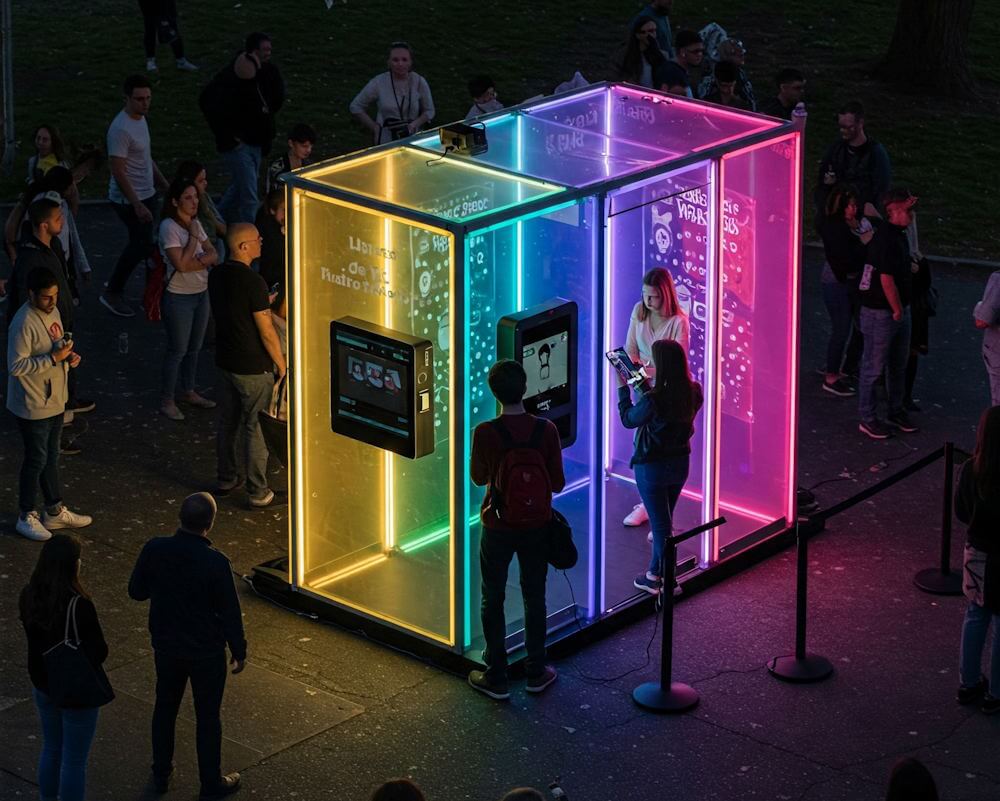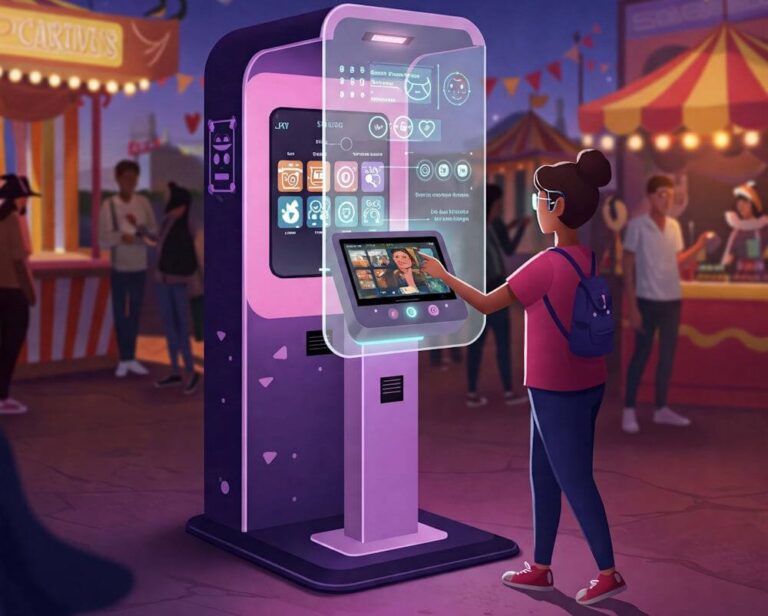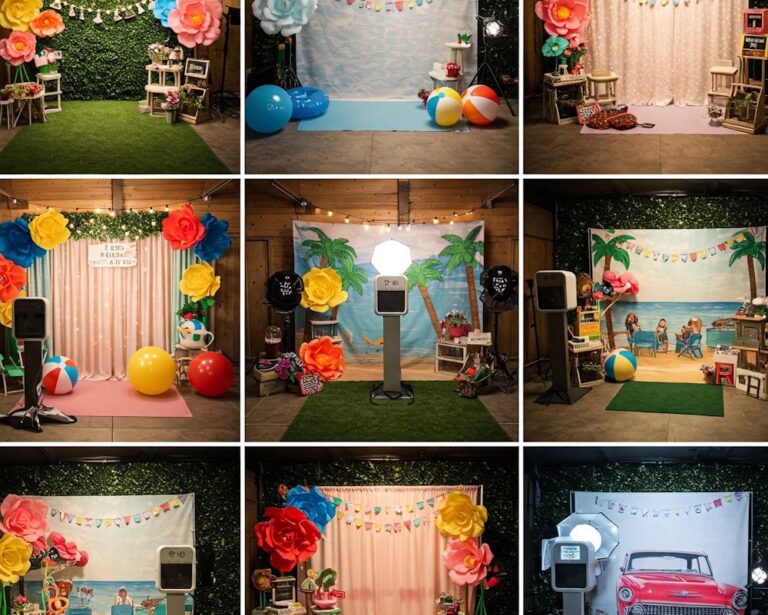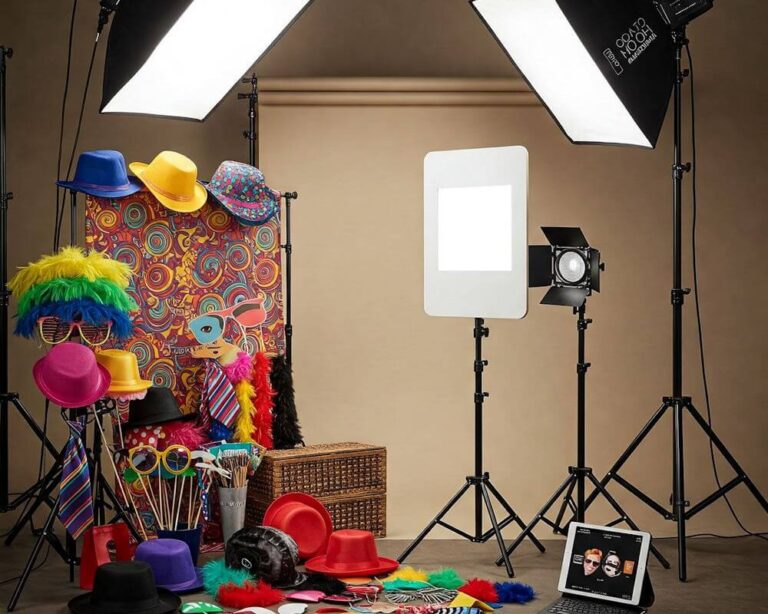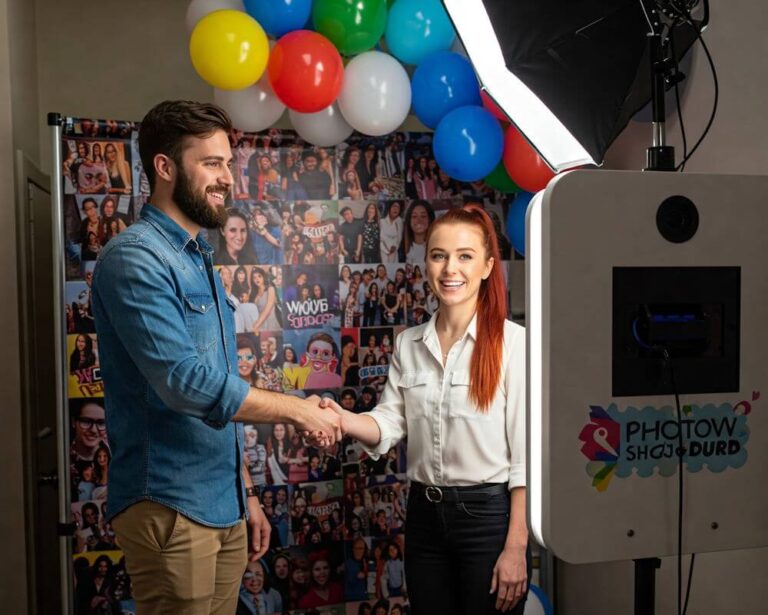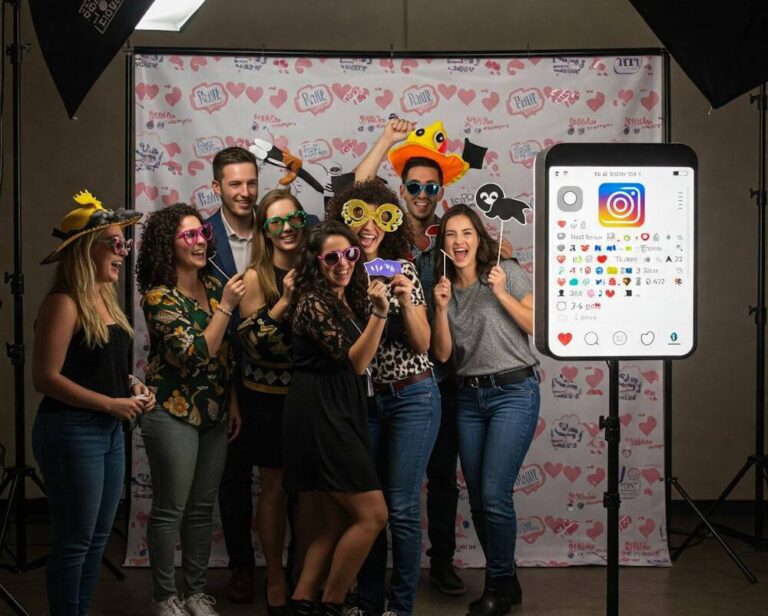Understanding the Purpose of a Photo Booth
The integration of photo booths at festivals and public events serves multiple purposes that enhance the overall experience for attendees. Primarily, these booths serve as an entertainment hub, providing guests with an engaging activity that encourages interaction and creativity. The spontaneous and light-hearted nature of capturing photographs helps break the ice among attendees, fostering social connections and collaborations among people who might not otherwise engage with one another.
Furthermore, photo booths present an excellent opportunity for event branding. As guests share their images on various social media platforms, they inadvertently promote the event, amplifying its reach and visibility. This user-generated content creates a buzz and can significantly enhance the event’s profile online. Organizers can enhance this branding further by incorporating event-specific visuals and hashtags, thus turning each photograph into a marketing tool that can attract a larger audience in the future.
In conclusion, the presence of a photo booth not only adds a layer of fun and entertainment but also plays a crucial role in event branding and fostering social interactions among attendees, making it an invaluable component of any festival or public event.
Choosing the Right Location
When designing an engaging photo booth for festivals and public events, selecting the optimal location is imperative to its success. One of the primary factors to consider is foot traffic. The ideal spot should be situated in a high-traffic area where attendees naturally congregate. This ensures that many people will pass by the booth, thereby increasing the likelihood of interaction. Observing previous events can offer insights into the busiest zones where crowd flow is most concentrated.
Another critical consideration is visibility. The photo booth should be positioned where it is easily seen from various vantage points across the venue. Utilizing eye-catching signage or decorations can further enhance its appeal. Therefore, ensuring the booth stands out amidst the event’s hustle and bustle will capture the attention of attendees and encourage them to participate.
Accessibility is also a fundamental aspect when choosing the photo booth’s location. It should allow for easy access to both users and staff, avoiding areas that might create bottlenecks or obstruct pathways. If positioning near food stalls or stages, make sure there is enough space for lines to form without causing inconvenience or congestion. Proximity to main attractions or activities is another factor that should not be overlooked. Ideally, the photo booth should be placed close to popular features of the event, such as performances or displays, as this will naturally draw guests toward it.
Finally, it is essential to consider spatial dimensions and crowd flow. It may be beneficial to design the layout so that lines can form efficiently, perhaps in a U-shape or serpentine pattern. This design facilitates movement and encourages more attendees to participate while minimizing frustration. By carefully evaluating these factors, one can effectively enhance the photo booth’s engagement level and ensure a memorable experience for all participants.
Design Elements: Aesthetics and Branding
When designing a photo booth for festivals and public events, aesthetics play a crucial role in attracting participants and enhancing their overall experience. First and foremost, choosing an appropriate color scheme is essential. Colors should align with the event’s theme and foster a lively atmosphere. Bright and vibrant hues often resonate well with festival-goers, drawing them toward the booth and creating an inviting ambiance. However, it is vital to ensure that the chosen palette complements other design elements for a cohesive look.
Backdrops are another significant aspect of photo booth design. An effective backdrop not only serves as a canvas for photographs but also sets the tone for the entire experience. High-quality materials and creative designs can transform the simple photo booth into a striking visual element of the event. Incorporating elements that reflect the festival’s essence or cultural significance can deepen the connection with attendees, making their photos memorable. Consider utilizing interactive or three-dimensional backdrops to provide unique photo opportunities, thereby enhancing guest engagement.
Moreover, props are a fun addition that encourages participation and creativity. These can range from playful hats and oversized sunglasses to event-specific items that reflect local culture or festival themes. Thoughtfully curated props allow guests to express their personalities and create personalized memories during their visit. This playful element can also foster social media sharing, increasing the event’s visibility online.
Incorporating branding materials and logos is equally important. Strategically placed logos can enhance brand recognition and contribute to building a positive association with the festival. Utilizing customized branding on photo booth elements, such as backdrops and props, ensures a seamless integration of aesthetics and marketing. These design components collectively create an engaging photo booth experience that not only delights participants but also promotes the event and its sponsors effectively.
Technological Considerations: Equipment and Software
When designing a photo booth for festivals and public events, the selection of technology is crucial for ensuring a seamless and enjoyable experience for users. The primary components that merit careful consideration include cameras, printers, lighting equipment, and software systems, each playing a pivotal role in the overall functionality and appeal of the photo booth.
For cameras, choosing a high-quality digital camera that captures sharp and vibrant images is essential. DSLR cameras are often favored for their superior image quality and adaptability in various lighting conditions. However, for budget-conscious events, high-end compact cameras can also provide satisfactory results. It’s advisable to consider models that offer quick autofocus and user-friendly interfaces to speed up the photographing process, thereby enhancing the user experience.
Equally important is the printer selection. Fast and reliable dye-sublimation printers are recommended as they produce prints that are high-quality and water-resistant, catering to the outdoor nature of festivals. Event planners should also assess the volume of anticipated prints and choose a printer capable of handling the workload efficiently.
Lighting is another critical factor to enhance the visual appeal of photos. Softbox lighting systems or ring lights can be effective in ensuring that subjects are well-lit, reducing harsh shadows and creating flattering images. Portable, battery-operated lighting solutions are ideal for outdoor settings, allowing flexibility in arranging the photo booth.
Lastly, the integration of intuitive digital software can elevate the overall experience. Photo booth software should offer interactive features, such as customizable filters and instant sharing options to social media platforms, which can significantly boost user engagement. Many software solutions are available that cater to different budgets and event scales, enabling event organizers to choose the right option tailored to their specific needs.
Incorporating Interactive Features
To enhance the overall experience of a photo booth at festivals and public events, incorporating interactive features is paramount. These functionalities not only engage users but also allow for a personalized and memorable experience. One of the most notable enhancements is the implementation of touchscreens, which enable users to customize their photo layouts. By allowing guests to choose backgrounds, frames, and filters, this feature can dramatically increase satisfaction and excitement. Guests are likely to spend more time interacting with the booth, leading to greater enjoyment and more memorable outcomes.
Another innovative aspect to consider is touchless activation. In a time where health and safety concerns are prominent, ensuring a seamless experience without physical contact can be an appealing alternative. By integrating motion sensors or smartphone compatibility, attendees can initiate their photo session simply by waving their hands or tapping their devices. This not only promotes hygiene but also adds a futuristic element to the experience, making it stand out among traditional setups.
Additionally, offering GIF creation within the photo booth can elevate user interaction exponentially. As this format continues to gain traction on social media, providing guests with the option to create animated gifs ensures they engage creatively with the booth. Furthermore, integrating social media sharing options empowers users to easily disseminate their creations, thereby extending the event’s reach far beyond its physical location. Guests can share their experiences in real-time, potentially increasing attendance and engagement for future events.
In summary, incorporating interactive features, such as touchscreens for personalized photo layouts, touchless activation, GIF creation, and social media integration, can significantly elevate the interactive experience of a photo booth. These innovations not only enhance user engagement but also encourage sharing, fostering a sense of community and connection among event attendees. By investing in these features, event organizers can create a more dynamic and memorable atmosphere that resonates well beyond the event itself.
Props and Accessories: Enhancing Engagement
When designing a photo booth for festivals and public events, the selection of props and accessories plays a crucial role in enhancing engagement. Well-chosen items can not only align with the festival’s theme but also encourage creativity and playful interactions among attendees. Creative props can evoke smiles and laughter, providing attendees with memorable experiences that resonate long after the event concludes.
One of the most effective strategies is to curate a diverse collection of props that reflect the theme of the festival. For example, at a summer music festival, vibrant sunglasses, inflatable musical instruments, and fun hats can all add to the festive atmosphere. On the other hand, a winter holiday event could feature props like reindeer antlers, snowflake-themed scarves, and festive masks, all designed to create a joyous ambiance. The aim is to foster a sense of connection and camaraderie among participants, enabling them to express themselves freely in front of the camera.
In addition to thematic props, incorporating interactive elements can further enhance the photo booth experience. For instance, adding a customized backdrop that mirrors the festival’s environment can make the photos even more special. Consider offering unique accessories, such as chalkboard speech bubbles for participants to write their own messages, or custom-made signs that promote the event’s branding. Such elements can facilitate creative interactions and provide guests with images they are eager to share on social media platforms, effectively amplifying the event’s reach.
Moreover, ensuring that props are safe and easy to use is essential. Lightweight items that can be quickly picked up and repositioned enhance the overall flow of the photo booth area. By thoughtfully selecting props and accessories, organizers not only enhance engagement but also help create unforgettable moments during the festival that attendees will cherish for years to come.
Promoting the Photo Booth
Effectively promoting a photo booth at festivals and public events is crucial for maximizing participation and visibility. One of the primary strategies is leveraging social media to create awareness before the event. Platforms like Instagram, Facebook, and Twitter can be utilized to share engaging content that highlights the unique features of the photo booth. Utilizing event hashtags and geotags can also help in reaching a wider audience. Creating eye-catching graphics, short video teasers, or even behind-the-scenes material can enhance excitement around the photo booth experience.
During the event, on-site signage plays a significant role in attracting attendees. Signs should be strategically placed near high-traffic areas to capture the attention of festival-goers. Incorporating QR codes on these signs that link directly to social media pages or event-specific photo galleries can encourage immediate engagement. Additionally, using bold and clear visuals can help communicate what makes the photo booth special, including any unique props or themed backdrops available for use.
Collaborating with influencers or local personalities can also amplify promotional efforts. Inviting them to share their experiences at the photo booth could provide authenticity and enthusiasm that resonates with their followers. Consider offering exclusive previews or photo opportunities for influencers to generate buzz around the booth. Moreover, utilizing their networks can extend your reach beyond standard promotional methods.
Lastly, implementing incentives such as giveaways or contests can significantly boost participation. Encouraging attendees to share their photos on social media platforms while tagging the booth can create organic buzz. Random draws for participants who post their images online can enhance interaction, making the photo booth an integral part of the overall festival experience. Such strategies ensure that the photo booth receives the attention it deserves and contributes positively to the event atmosphere.
Operational Considerations: Staffing and Logistics
When organizing a successful photo booth experience at festivals and public events, careful attention must be paid to the logistical aspects of operation. A thorough understanding of staffing and workflow dynamics is essential for ensuring that the photo booth runs smoothly and effectively engages attendees. The first key consideration is determining the appropriate number of staff members required for operation. Typically, a team of two to four operators ensures that each guest has adequate assistance while maintaining an efficient workflow.
Each staff member should be assigned specific tasks, such as equipment management, guest interaction, and line control. One staff member can be tasked with managing the technical aspects of the booth, including troubleshooting any equipment issues, ensuring a seamless process for users. At the same time, another staff member should focus on assisting guests with poses and props, helping them make the most of their photo booth experience. It is important to also have staff ready to manage the line effectively, ensuring that guests do not face long waiting periods and that the flow of traffic remains consistent.
In terms of logistics, comprehensive planning for setup, maintenance, and breakdown is crucial. Setting up the booth should take place well before the start of the event to allow for adjustments and testing of the equipment. During the event, regular maintenance checks are necessary to ensure the photo booth is functioning correctly and that supplies such as backdrop materials and props remain stocked. Finally, at the event’s conclusion, a thorough breakdown process must be followed to pack up equipment safely and leave the venue in good condition. By adhering to these operational considerations, event organizers can enhance the attendee experience and create memorable photo opportunities.
Evaluating Success: Metrics and Feedback
To effectively assess the success of a photo booth at festivals and public events, it is essential to implement a structured evaluation process. This involves analyzing key performance indicators (KPIs) that reflect the photo booth’s impact on attendee experience and engagement. Metrics such as the number of photos taken, social media shares, and direct attendee feedback serve as valuable indicators of the booth’s effectiveness.
One primary metric to consider is the total quantity of photographs captured during the event. Tracking this number provides insight into how engaging and accessible the photo booth is for attendees. Additionally, a high volume of prints or digital photos can suggest that the booth has successfully attracted participants and encouraged them to interact with the booth and its features.
Social media engagement can also be a critical indicator of success. By encouraging attendees to share their photos on platforms such as Instagram, Facebook, or Twitter, organizers can gauge the booth’s popularity and reach. Utilizing specific hashtags tied to the event allows for easier tracking and engagement analysis. The number of likes, shares, and comments on these posts can further illustrate the photo booth’s impact on branding and social interaction.
Moreover, gathering direct feedback from attendees through surveys or comment cards can provide qualitative insights into their experience. Questions regarding what they enjoyed about the booth, any technical issues, or suggestions for improvement can inform future photo booth designs. Timing the feedback collection, either during or immediately after the event, can yield more accurate responses, as participants’ experiences will be fresh in their minds.
By focusing on these metrics and continuously evaluating feedback, event organizers can better understand the strengths and weaknesses of their photo booth offerings. This iterative approach not only enhances the overall experience for attendees but also contributes to the improved design and functionality of future photo booths at events.

